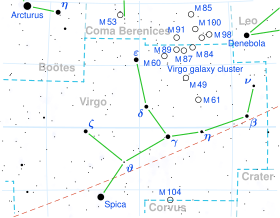Sigma Virginis
In this article, we will delve into the fascinating world of Sigma Virginis, exploring its origins, evolution and relevance today. From its earliest roots to its impact on modern society, Sigma Virginis has played a significant role in various fields, capturing the attention of people of all ages and interests. Through detailed analysis, we will examine the key aspects that have contributed to Sigma Virginis's popularity and relevance, as well as its influence on contemporary culture. With a multidisciplinary approach, we will address the different aspects of Sigma Virginis, from its historical importance to its impact on technology and innovation, providing a comprehensive view of its importance in today's world.
| Observation data Epoch J2000 Equinox J2000 | |
|---|---|
| Constellation | Virgo |
| Right ascension | 13h 17m 36.28327s[1] |
| Declination | +05° 28′ 11.5221″[1] |
| Apparent magnitude (V) | 4.86[2] |
| Characteristics | |
| Spectral type | M1 III[3] |
| U−B color index | +1.86[2] |
| B−V color index | +1.62[2] |
| Variable type | suspected[4] |
| Astrometry | |
| Radial velocity (Rv) | −28.26±0.30[5] km/s |
| Proper motion (μ) | RA: −6.06[1] mas/yr Dec.: +9.14[1] mas/yr |
| Parallax (π) | 4.83±0.19 mas[1] |
| Distance | 680 ± 30 ly (207 ± 8 pc) |
| Absolute magnitude (MV) | −1.80[6] |
| Details | |
| Radius | 98[7] R☉ |
| Luminosity | 1,610[7] L☉ |
| Surface gravity (log g) | 0.42[7] cgs |
| Temperature | 3,690[7] K |
| Other designations | |
| σ Vir, 60 Virginis, BD+06°2722, FK5 1344, HD 115521, HIP 64852, HR 5015, SAO 119855[8] | |
| Database references | |
| SIMBAD | data |
Sigma Virginis (σ Vir, σ Virginis) is a star in the zodiac constellation of Virgo. It can be faintly seen with the naked eye with a baseline apparent visual magnitude of 4.86.[2] Based upon parallax measurements, the distance to this star is roughly 680 light-years.

This is an evolved red giant star with a stellar classification of M1 III.[3] It is a suspected variable star with a brightness that ranges from magnitude +4.77 to +4.86.[4] This variation has pulsation periods of 23.4, 24.3, 27.9 and 34.1 days.[3] The effective temperature of the stellar atmosphere is around 3,800 K, and it shines with 1,734 times the luminosity of the Sun.[7]
References
- ^ a b c d e van Leeuwen, F. (November 2007), "Validation of the new Hipparcos reduction", Astronomy and Astrophysics, 474 (2): 653–664, arXiv:0708.1752, Bibcode:2007A&A...474..653V, doi:10.1051/0004-6361:20078357, S2CID 18759600.
- ^ a b c d Mermilliod, J.-C. (1986), "Compilation of Eggen's UBV data, transformed to UBV (unpublished)", Catalogue of Eggen's UBV Data, SIMBAD, Bibcode:1986EgUBV........0M.
- ^ a b c Tabur, V.; Bedding, T. R. (2009), "Long-term photometry and periods for 261 nearby pulsating M giants", Monthly Notices of the Royal Astronomical Society, 400 (4): 1945–61, arXiv:0908.3228, Bibcode:2009MNRAS.400.1945T, doi:10.1111/j.1365-2966.2009.15588.x, S2CID 15358380.
- ^ a b Kukarkin, B. V.; et al. (1981), "Nachrichtenblatt der Vereinigung der Sternfreunde e.V. (Catalogue of suspected variable stars)", Nachrichtenblatt der Vereinigung der Sternfreunde, Moscow: Academy of Sciences USSR Shternberg, Bibcode:1981NVS...C......0K.
- ^ Famaey, B.; et al. (2005), "Local kinematics of K and M giants from CORAVEL/Hipparcos/Tycho-2 data. Revisiting the concept of superclusters", Astronomy and Astrophysics, 430: 165–186, arXiv:astro-ph/0409579, Bibcode:2005A&A...430..165F, doi:10.1051/0004-6361:20041272, S2CID 17804304.
- ^ Anderson, E.; Francis, Ch. (2012), "XHIP: An extended hipparcos compilation", Astronomy Letters, 38 (5): 331, arXiv:1108.4971, Bibcode:2012AstL...38..331A, doi:10.1134/S1063773712050015, S2CID 119257644.
- ^ a b c d e McDonald, I.; Zijlstra, A. A.; Watson, R. A. (2017), "Fundamental parameters and infrared excesses of Tycho-Gaia stars", Monthly Notices of the Royal Astronomical Society, 471 (1): 770, arXiv:1706.02208, Bibcode:2017MNRAS.471..770M, doi:10.1093/mnras/stx1433, S2CID 73594365.
- ^ "sig Vir", SIMBAD, Centre de données astronomiques de Strasbourg, retrieved 2016-09-16.
- ^ "/ftp/cats/more/HIP/cdroms/cats", Centre de Données astronomiques de Strasbourg, Strasbourg astronomical Data Center, retrieved 15 October 2022.
